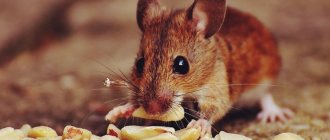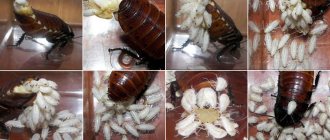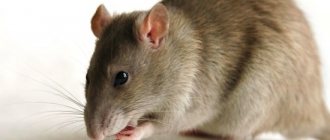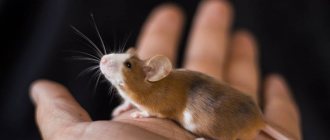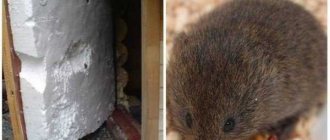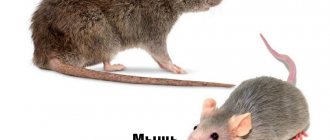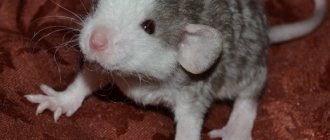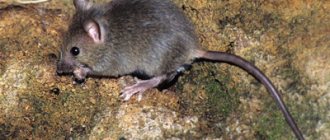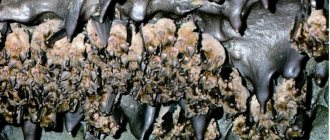Not only breeders, but also rodent fighters need to know how mice reproduce and how long they live. Cute domestic animals and terrifying street dwellers, under favorable conditions, are able to reproduce all year round.
Only at sub-zero temperatures does the female stop estrus and the males are not interested in her. An individual gives birth to about 10 cubs at a time, and the next litter may appear 1-2 months after the previous one.
During this period, the babies grow up and are able to become fertilized themselves.
Birth and development of pups in mice
Pregnancy in house mice lasts on average 22 days (20-26 days) and it proceeds easily and without complications.
Typically, in mice, the fetuses in the uterus are located with their heads towards the exit of the uterus and there is no pathology of birth, and cases of death from childbirth among mice are very rare. Childbirth usually occurs at night. One litter usually contains from five to nine mice. It is interesting that just a day after giving birth, the female comes into estrus and is again ready for mating and can become pregnant again. In females, lactation and pregnancy can sometimes occur simultaneously. Therefore, almost every female house mouse can give birth to up to 10-11 litters in a row. But such intensity of reproduction greatly exhausts it. For this reason, to obtain good offspring, no more than nine litters are allowed.
In normally kept female mice, stillborn pups are quite rare. The reason for this may be a lack of vitamins and microelements in the feed, as well as some infections. But baby mice that were born normal sometimes die soon after birth due to some reason. This may be the lack of milk in the female, an underdeveloped instinct of motherhood, or stress, due to which the female tries to hide the mice, dragging them around the cage, as a result of which they die. Sometimes it happens that pups are born underdeveloped, as they were stunted in growth during the embryonic period, which is most often associated with insufficient and poor-quality nutrition of the female during pregnancy.
Since such pups, as a rule, die, the birth of weak litters serves as a signal of problems associated with the diet or feeding of the animals. But the death of offspring during closely related breeding of mice is almost never observed. Sometimes mice may be born smaller than normal, but, as a rule, they quickly gain the required body weight.
Mice are born naked and with their eyes and ears closed. On average, the weight of newborn mice is about 1-2 g, with a body length of about 3 cm. The mice are born helpless and practically do not move. In newborn mice, determine the sex, i.e. It is almost impossible to distinguish females and males. But at a later age, males become larger than females.
During this period, it is necessary to maintain high milk production of the female. There should always be good quality milk and fresh water in the cage. Newborns grow quickly. Their mass doubles on the fourth or fifth day, and the linear dimensions of the body increase. On the third to fifth day after birth, the baby mice's ears open and their bodies begin to become covered with hair. The first teeth - the lower incisors - erupt on the eighth day, and the upper ones - on the 14th day after birth. At two weeks of age, the mice's eyes open and they begin to see the world around them. The pups emerge from the nest around the third week of life and from that time begin to consume food on their own. The weight of mice at this age averages about 8-8.3 g.
Soon after this, on the 20-25th day after birth, the young animals are weaned from females and mother's milk. At the same time, if the female is lactation and pregnant at the same time at this time, then the young animals should be weaned at least a day or two earlier than the stated period. And immediately during jigging, it is advisable to seat the males and females in different cages to avoid their mating. And after weaning from mother's milk, the pups continue to grow rapidly, reaching 11-12 g by the age of one month, depending on gender, their body length is about 6 cm, and their tail is about 5 cm. And only by six to seven months in whites mice complete their growth and development and stabilization of body weight and linear dimensions occurs. By this time, young house mice already weigh about 25-30 g. In the future, the body weight of adult mice may change depending on the quantitative and qualitative indicators of feeding and also depend on the conditions of keeping the mice.
Development of little mice
Despite the fact that newborn mice are very tiny and can navigate only by smell, they have an excellent appetite. They immediately find the mother's nipple and begin to eat. Baby mice grow very quickly. Moreover, usually, regardless of the number of pups in the litter, they develop at the same pace, since weak individuals that have no chance of survival are eaten by the mother soon after birth. Approximate development schedule for newborn mice:
- on the 3-4th day the first fluff appears on the body;
- on days 4-5, the ears open and rise;
- on days 6-7, almost the entire body is covered with fur and the first teeth begin to cut;
- On days 12-13, the eyes open.
In the third week of life, the mice finally develop all motor functions, they can run and eat solid food. After only 3-4 weeks, the pups become independent and can do without their mother.
Physiological abilities
In the wild, the process of pregnancy and birth is regulated independently and directly depends on climatic conditions and the availability of food. At home, a lot depends on the person.
The mouse becomes sexually mature at the age of 30 to 50 days, depending on the variety and living conditions. However, the final formation of the animal ends by 12 months. Early fertilization can cause significant harm to the body, and the animal runs the risk of dying during childbirth.
It is allowed to mate a domestic mouse at 6 months; in nature, this moment occurs a little earlier. In a year, a female can reproduce up to 8 offspring. But this rarely happens, for several reasons.
- In nature, mice reproduction ends with the onset of cold weather.
- At home, pregnancy is controlled by a person.
On average, one mouse gives birth 4 times per year. The ability to fertilize appears 14 hours after birth. The estrus period lasts 18 hours. The entire mating season is very fast - 5 days.
Mating and pregnancy in rodents
Cubs
Mice are born naked, blind, deaf, with undeveloped limbs. But they have an excellent appetite, and significant changes occur daily in physical development:
- in a week they are already cute fluffy creatures;
- after 14 days, hearing appears and the eyes open;
- At 3 weeks of life, the mice crawl out of the nest and explore the space.
It is not recommended to pick up small babies, as the mouse may refuse them. But from the 20th day of life, this must be done so that the mouse grows tame. At 30 days, the offspring become independent and can be given to other hands.
Mice reproduce quickly; under comfortable conditions, the process can continue continuously. But the female spends a lot of energy on feeding the mice, pregnancy, and childbirth. Therefore, the higher the birth rate, the weaker the health of the adult.
Pregnancy
At home, individuals of the opposite sex live in different cages and live together during the mating season. Wild mice mate with several males at once, this increases the chances of “success”.
Small rodents bear their young for about 24 days. The pet's diet is increased by 1/3 in the first stage of pregnancy, and by half before birth. The general well-being of the female and the well-being of pregnancy depend on what the mouse eats.
Mice suffer from toxicosis at any stage of gestation. External signs are drooping eyelids, increased salivation, poor appetite, decreased activity. Toxicosis cannot be treated. It is necessary to provide the pregnant female with peace and less handling.
During pregnancy, it is necessary to keep the cage clean, leave paper, pieces of fabric, and hay. So that the mother mouse prepares a nest, a place for childbirth.
Few people get to see how mice are born, since the process occurs at night. Lasts about 2 hours. Before giving birth, it is necessary to clean the cage, disinfect it, and add fresh hay.
How many mice are born at one time - from 5 to 14. In the wild, the average number of babies is 11. Among them there may be dead and weak ones. The mouse eats them, allowing strong offspring to receive more milk.
If the male lived in a cage with the female until the birth, he should be removed the day before. Because the father is capable of eating his own young. Very often this phenomenon occurs in nature if the female leaves the nest for a while. The male does not participate in raising the offspring.
If contractions last a long time and the female cannot give birth, call a veterinarian. When the time for birth comes, there are no contractions, but the mouse behaves actively, eats the food offered well - there is no reason to worry. Breeding each species has its own characteristics; the duration of pregnancy can vary up and down.
Selection, preparation, rules of use for future parents
Successful reproduction largely depends on the correct selection of a pair. All candidates are carefully assessed, analyzing:
- constitution and physique;
- fatness;
- quality of the fur coat;
- fertility if mice have already been bred.
Both the female and the male must be strong, outwardly healthy, well-fed, but not obese.
If the female has already given birth, then the best is considered the one that:
- was a wonderful mother;
- brought an average number of mice;
- had a high lactation rate.
Animals that have a history of eating their offspring or animals that suffer from excessive aggression should not be allowed into breeding.
The female can be used no more than twice during the year.
Frequent childbirth significantly undermines health, and an unrestored body is unlikely to be able to provide future offspring with everything necessary for full development. Thus, it was noticed that the cubs of females who had exhausted their strength were born weak, developed poorly and died prematurely.
Males are also used wisely: frequent mating depletes reproductive function and the mouse may simply remain unfertilized.
Before mating, animals are provided with complete feeding with a sufficient amount of vitamins (especially E) and microelements.
Obese rodents, which most often turn out to be temporarily infertile, are forced to move as much as possible, and foods rich in carbohydrates are excluded from their diet.
There should be no more than ten females per male. They can be kept all together, but it is better to place each animal in its own cage, placing the females with the male as needed at the time of estrus.
Mice breeding
Small rodents are quite cute, but they inspire fear in most people, as mice reproduce at an enviable rate. If control is weakened, the scale of the disaster can be impressive. Moreover, it is important to know this for both amateurs and irreconcilable opponents.
About three hundred species of mice inhabit the globe; three species annoy people:
Domesticated, that is, decorative pets, have been bred into a separate species. Breeders need to understand that animals in captivity can give birth regardless of the season, but in the wild only at above-zero temperatures (during the cold season they do not go into heat and females are completely uninteresting to males). But there is a category of individuals that do not depend on the species. These are the ones that secretly sneak into warm rooms in the fall (cellar, bathhouse, etc.) and are ready for year-round reproduction. They are the worst. Homeowners need to take care in advance to protect themselves from unwanted guests.
Care: mouse by mouse, and cleaning on a schedule
In fact, the house mouse does not need any special care. But taking care of the cleanliness of the cell is the most important condition. And not only for the animal, but also for the owner. The life cycle of these rodents is so intense that the cage needs to be cleaned at least twice a week. Otherwise, you are guaranteed to have a mouse smell in your apartment.
Cage cleaner
By “cleaning the cage” we mean changing the bedding and wiping all objects in the cage with a special product or soapy water. If you take the trouble and purchase a cage with a retractable tray, the cleaning process will be greatly simplified and will not take much time.
Feeding
Domestic mice, like their wild relatives, are omnivores. But under natural conditions, the mouse age is short and is marked by various diseases. It is in your power to avoid trouble and make sure that your pet eats well, does not get sick and does not cause trouble throughout its mouse life.
The mouse eats
The main rule is the same as for humans: a balanced diet. For you this means a combination of dry and succulent food:
- Dry: grains and seeds, as well as bread, crackers, mixed feed. Mice also happily eat budgie formula and even dry cat and dog food;
- Juicy: apple pieces, sprouted grains, green beans, not very juicy herbs. It is useful to offer insects in the diet from time to time: flies, butterflies and even cockroaches;
- Supplementing with vitamins and minerals once a month will also not be superfluous.
But what you absolutely cannot do is feed rodents with leftover food from your own table: food additives, spices and excess salt can harm your pet. If only occasionally indulge in a piece of cheese or other natural product, but not as the main diet.
Communication
Get ready for the fact that mice are nocturnal creatures, which means that most of your waking hours they will sleep or hide in their house or nest of litter, and rustle at night. But even with this way of life, a mouse, like any living creature, needs communication. At the same time, a lonely mouse needs much more of it than a family of mice. If you devote too little time to a rodent, it will soon become gloomy, withdrawn, quickly run wild and will hide when a person appears.
Don't let the mouse run wild
To make your pet active and friendly, talk to him, sit him in your palm, and play more often. It won’t take much time and won’t require excessive effort, but the return will not be long in coming and will be like in that cartoon: you come home, and he is happy with you.
And remember - we are responsible for those we have tamed!
Factors affecting reproduction
Rodents become sexually mature quite quickly. Based on environmental conditions (climate, food), readiness for conception, gestation and childbirth occurs already at one month of age. Some varieties may be slightly delayed - by 15-20 days. But the onset of maturity does not indicate that the female’s body is ready for reproduction.
He reaches the required condition only by the third month from birth. It is impossible to track this in the natural environment, but it is quite possible to protect a pet from premature pregnancy.
Puberty
The moment when the mouse is ready to give birth to a new batch of small pests comes quite quickly. When about one and a half months have passed since birth, the rodent has already reached puberty . However, a mouse can fully give birth to children only after two to three months. In this case, the physical condition of the expectant mother is of great importance. She must be completely healthy, eat well and be in favorable conditions. If at least one of these points is missing, then the pregnancy may have complications, which will greatly affect the health of the female. Miscarriages may occur, and stillborn or sick cubs may be born.
Puberty and fertility
Considering the short life cycle of a mouse, the onset of childbearing in the wild begins with the onset of puberty (30-50 days). And breeders are advised not to mate animals until 2-3 months (more correctly, up to six).
Often decorative creatures are overweight, and, of course, they also give birth to large babies. The litter itself is more numerous when kept in captivity. All this is very risky for the female’s fragile body.
"It is important to know! When preparing mice for mating, they should be switched to green food and sprouted cereals, since obese animals are not capable of conceiving.”
To avoid uncontrolled mating, males and females are kept in separate cages. They should arrange a date only when the female is in heat. It doesn’t matter on whose territory the meeting will take place.
Understanding a female's readiness is quite simple. Her habits change a lot. It shows up like this:
- The mouse becomes anxious and embittered;
- falls with his stomach to the floor and raises his pelvis;
- does not repel the male and is eager for mating games.
The female's estrus lasts 5 days, but the most fruitful period occurs on the third day and lasts from 10 to 18 hours.
When planning a pregnancy, you should know that the female is ready for mating within 14 hours after giving birth. But this is a big burden for the fragile body of a woman in labor. Moreover, colossal amounts of effort go into feeding newborns. Therefore, it is advisable to carry out mating no more than 4 times a year.
Birth of offspring
The birth process takes about two hours, most often the attempts begin at night or in the evening. The male does not need to be removed from the cage; as a rule, he helps the mother in labor in caring for the newborns.
How many mice does a mouse give birth to? There is no certainty in this matter: one mouse may appear, or a dozen at once.
On average, five to eight mice are born at a time.
Typically, childbirth proceeds well, but complications are possible that require all possible assistance:
- absence of the mouse within 15 minutes after the start of pushing;
- stopping the birth process after the birth of the first baby is considered a complication only if it is certain that there are still fetuses left in the uterus;
- the fetus comes forward with its hind legs - this fact is not dangerous for the mother, but the baby can suffocate in the birth canal;
- fetal entrapment - usually occurs with large fetuses or the first birth in animals that are too old;
- intrauterine death of mice.
All the difficulties described require intervention from specialists. In some cases, you will have to resort to surgical obstetrics, while in others you can get by with the injection of special sex hormones.
Childbirth. Process duration
Observing the birth process of mice is quite difficult, since females usually give birth at night. If the process progresses well, labor is completed in two hours.
A few days before the expected birth, you should clean the cage and take a closer look at your pet.
If she is active and eats the food offered well, then there is no reason to worry. You should contact a veterinarian if there are contractions, but the babies cannot be born. Pushing without results for more than 15 minutes can be fatal for the female.
The voices of baby mice will notify you of the successful outcome of the birth. But you should not interfere with the process of adaptation of babies and mothers to the new state. The female may not like the foreign smell in the nest. This threatens her with abandonment of offspring or even extermination of children.
How does mating happen?
Males show special interest in females during estrus. You can notice the moment when a representative of the fairer sex is ready for mating by such signs as: tranquility, characteristic arching of the back, spreading of the hind limbs. So that animals can continue the race, they are placed in the same cage. Mice can mate at any time of the day, so there is no need to choose a special moment.
After copulation, the female is placed in a separate cage. After 2 hours, she is again sent to the same male for re-covering. Next, the female mouse is observed until the expected next estrus; if it does not occur, it means that fertilization was successful.
How to get rid of mice in an apartment forever?
Doing this quickly is not always possible. Mice and rats are cunning and dexterous rodents, so you need to be patient to deal with them. In addition, the number of one colony sometimes reaches 120-150 individuals - coping with such a number of rodents quickly is quite a difficult task.
You can resort to traditional methods, which we will talk about later, or you can use modern methods - as they say, to your taste.
Ultrasonic repellers
This is something that is not audible to the human ear, but can cause severe anxiety for rodents - to the point that they leave the place where there is this kind of irritant. There is nowhere to hide from it - invisible waves fill the entire space, being a “headache” for mice, disrupting their life cycle and reproduction. For animals, this becomes a significant reason to leave the room to which they will never return - mice have long-term memory and are unlikely to want to live in a place where they were constantly disturbed by ultrasound in the future.
Models of devices are provided for both large rooms and smaller rooms - usually the manufacturer declares efficiency for the maximum area - in reality it can differ by 20%. To completely eliminate rodents, it is necessary for the device to operate continuously for about 7 days.
They can be used to expel rodents from the apartment and to prevent their unwanted appearance. Highlight:
Folk remedies
Among the folk methods of control there is gypsum, which is mixed with flour in equal parts and placed in different containers, which are then placed in places where rodents accumulate or near their burrows. It is necessary to leave water for the mice near these containers, since the eaten mixture of flour and alabaster will inevitably make the animals thirsty. Water will cause the plaster to harden, causing the death of the pest. The method has a great advantage over chemical mixtures - it will not cause poisoning by accidentally getting on food, and will not poison pets who may eat the mixture or a poisoned mouse.
Also an effective remedy for mice is ash - more precisely, the alkali it contains, which can cause inflammatory processes on the paws, and then in the mouth of the rodent. Broken glass also has a damaging effect - the main thing is that the fragments are small.
Traps and mousetraps
Mousetraps are a method that has long been popular. However, if there are too many rodents in the room, one such trap may not be enough, so it is better to install several mousetraps in different rooms. For better effectiveness, use pieces of food that emit odors that attract rodents - sausage, bread, lard. Today, electric mousetraps have been developed - the high-voltage discharge of which instantly kills the animal.
Glue - the essence of its work is to immobilize an animal that falls on cardboard or plywood with a composition applied to it. The glued animal cannot leave, and sometimes several rodents fall into this trap at once. A small drawback of such a fight is the squeaking and “fussing” that the animal can make in an attempt to come unglued and run away.
An example of such a trap is the Medilis glue trap (detailed characteristics and method of use can be found here). This is an effective rodent control product with a non-toxic sticky composition. The trap should be placed in a place where rodents constantly move and left for 1-2 days. In this case, the area of the premises should be taken into account - calculation - 1 trap per 10 sq. m. After a couple of days, the traps must be inspected - they may either have animals attached to them, or be contaminated with dust - in both cases they become unsuitable for further use. It is important that other pets do not fall into such a trap - it is better to temporarily transport the animal. Although the drug has low toxicity, it is important to ensure that it does not get into the eyes - if this happens, be sure to rinse the mucous membranes with plenty of running water.
Professional pest control
Today, the total extermination of rodents in premises can be carried out with the help of special services that use professional means that are most effective in controlling rodents and minimally toxic to humans.
Professional help is sought when other methods have not proven effective, or there is simply no way to deal with the issues of eliminating mice. The method is paid - in different regions the price can reach from 3 thousand for a small room. But most often it justifies itself - deratization is carried out by specially trained people who know exactly where and how to spray the composition. Deratization can be a preventive measure, or it can be a necessary measure. After such treatment, rodents are guaranteed to leave the premises for up to 1 year - only in 2% of cases is repeated treatment required.
Conclusion
Methods of rodent control largely depend on the premises and size of the colony. If one of the methods turns out to be ineffective, they can be successfully combined - in this case, it is necessary to take into account the presence of pets - if a poisoned mouse is eaten by a cat or dog, the pet will be poisoned, which may result in death.
Source
Description of the external appearance of the spiny mouse - akomis
At first glance, it may seem that the spiny mouse is a rather large animal, but if you look closely, you will notice that its body does not exceed 11–13 cm in length, and its tail appendage, which grows to about the same size as the whole body.
On the face of this mammal one can see beautiful, very large eyes, black in color, and large ears, which are placed vertically and have a regular, slightly rounded shape. The ears have the ability to move. The muzzle itself is quite narrow, probably for this reason this rodent was called the spiny mouse. Near the oral cavity you can see long vibrissae; these elements greatly help the animals navigate in their natural habitat. The entire surface of the mouse’s body is covered with thick and fluffy fur, soft in texture; in addition, this representative of mice has one more feature - in addition to the fur, on the dorsal side of its body there are also small needles, which are slightly softer and shorter than those of a hedgehog . The tail process is devoid of any vegetation, it is bald and covered with so-called scales. This is a very vulnerable part of the body that breaks often. Nature has painted this rodent in a variety of shades; the color scheme on the animal’s body varies from light yellow to smoky gray. Whatever the color of this animal, with age the color gradually darkens and becomes more pronounced and saturated. In addition, an adult male can be easily distinguished from a young animal by the presence of a thick layer of fur around the neck, which resembles a lion’s mane. The limbs of the akomis are very small and short, ending in small claws. These amazing animals have one special feature - the ability to regenerate; like lizards, they can shed their tail and even some areas of their skin in case of danger; no scars or wounds remain in this place, and after some time the skin is completely restored.
